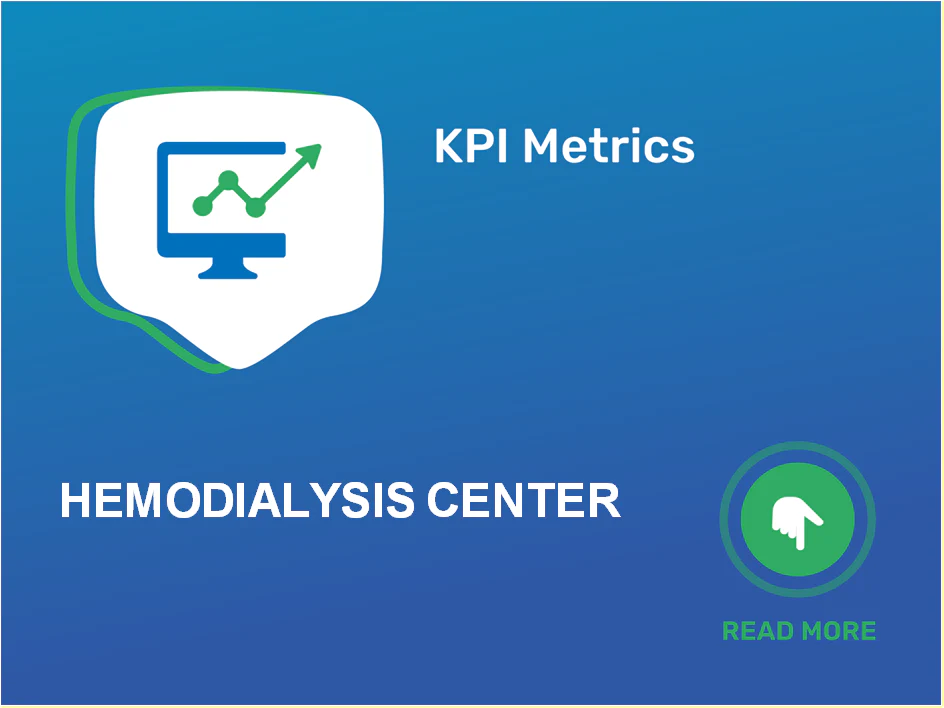Introduction
Dubai has become one of the most demanding markets for dialysis care. Regulatory burdens from MOHAP and DHA/NABIDH, rising patient expectations, and high operational costs combine to create a margin-sensitive environment. Clinics that grow largely on intuition—adding chairs, hiring staff—often find that scale magnifies inefficiencies, compliance risk, and financial leakage.
To thrive in 2025 and beyond, dialysis clinics in Dubai must adopt a data-driven operational model. That means tracking the right KPIs weekly, embedding them into protocols and workflows, and using software built for dialysis units—not general clinic EMRs.
The recent LinkedIn article, “Is Your Dialysis Clinic Benchmarking Against the Right KPIs?”, lays out five core metrics (chair utilization & no-show rate; EMR completeness & protocol compliance; consumable tracking & inventory variance; AR aging & claims denial rate; patient satisfaction & feedback loop). TopEMR.ae’s recent articles confirm that these are not optional—they are the difference between audit-ready clinics and those constantly firefighting emergencies (wait times, billing errors, patient dissatisfaction).
Below I map those five KPIs into the Dubai context, integrating evidence and examples from TopEMR, and show how Clinicea supports each metric. The goal: guide clinic managers, operators, and founders in Dubai in the next-steps to embed measurement and operational discipline in their clinics, every week.
1. Chair Utilization & No-Show Rate
Why Dubai Makes This Metric Critical
- High fixed costs: Dialysis machines, water treatment systems, staff wages — the cost of an idle chair is steep in Dubai’s labor and utility environment.
- Patient expectations & reputation: Long wait times and chairs empty during peak demand hurt patient satisfaction and referrals. TopEMR reports that clinics using manual scheduling suffer overlapping booking, under-utilization, and long idle periods between sessions.
- Regulatory expectations: DHA/NABIDH audits often review scheduling, wait times, delays as part of patient care standards. Clinics that can show solid utilization and low no-show rates under pressure are more audit-resilient.
How to Measure and Track Weekly
| Metric | What to Monitor Weekly |
| Chair Utilization | % of treatment-hours actually used vs available; open vs unused slots per shift |
| No-Show Rate | % of no-shows; repeat offenders; slots lost vs rescheduled |
| Wait Time / Treatment Delay | Time from arrival to first needle; delays caused by setup, staffing, consumables |
How Clinicea Helps
- Assign each treatment to a specific chair/machine and time slot, avoiding double booking.
- Automated SMS/email confirmation + auto-rescheduling flows for no-shows.
- Real-time dashboards showing chair utilization, open vs used capacity across clinics. Leadership can spot under-used slots.
2. EMR Completeness & Protocol Compliance
Dubai’s Audit & Patient-Safety Imperatives
- MOHAP / DHA / NABIDH audits are rigorous. Missing vital signs, unsigned or incomplete treatment flowsheets, lack of consent documentation repeatedly show up in audit findings.
- Clinical risk: dialysis is procedure-intensive. Variability in vascular access checks, eGFR staging, vital monitoring increases adverse events.
Key KPI Components
| Metric | What to Monitor Weekly |
| % of fully complete treatment flowsheets | All required vitals, physician notes, consents, access site checks |
| Protocol compliance rate | Following standard workflows (e.g. heparin dosing, access site prep) |
| Deviations / exceptions | Number of sessions flagged for missing data or protocol deviations; time to corrective action |
Clinicea’s Built-in Support
- Dialysis-specific EMR templates with mandatory fields; session closure locked until completed.
- Auto-calculation of eGFR, CKD staging, integrated protocol prompts.
- Dashboards that flag deviations in real time; leadership can review weekly compliance trends.
3. Consumable Tracking & Inventory Variance
Why This is a Major Cost & Compliance Factor in Dubai
- Consumables (dialyzers, syringes, fluids, anticoagulants) represent a large share of recurring cost. TopEMR estimates that mis-management here causes 10-15% cost leakage in many clinics.
- Stockouts delay treatments; expired or misbilled supplies lead to insurance or regulatory issues.
What to Track Weekly
| Metric | What to Monitor Weekly |
| Inventory variance | Physical vs recorded stock; differences by category |
| Consumables usage per session | Expected vs actual usage; waste or overuse |
| Stockouts / expiry incidents | Number, frequency, impact on scheduling/treatment |
Clinicea’s Capabilities
- Real-time inventory dashboards, batch & expiry tracking, auto-deduction of consumables tied to patient sessions.
- Cross-site stock visibility for multi-unit clinics.
- Automated reorder alerts when thresholds are breached.
4. Accounts Receivable Aging & Claims Denial Rate
The Dubai Revenue & Insurance Challenge
- Majority of dialysis reimbursement is through insurers, often under strict coding and documentation standards. Errors in consumable billing, ICD/HCPCS coding, or missing protocol documentation lead to claim denials or delays.
- Cash flow in clinics is affected when accounts overdue (60-90 days) accumulate. Maintaining liquidity is especially important as operational costs (staffing, utilities, supplies) are high.
Weekly Metrics to Monitor
| Metric | What to Monitor Weekly |
| AR aging buckets | % of invoices in 30-, 60-, 90+ days; trend of aging over weeks |
| Denial rates | By payer, by type (consumable, protocol, documentation) |
| Billing accuracy | Number or % of statements rejected or requiring resubmission |
How Clinicea Helps
- Integrated billing tied directly to EMR + consumable tracking so fewer missing items in claims.
- Dashboards showing AR aging, payer-wise denial trends.
- Pre-claim audits or automated checks for missing documentation or protocol deviations.
5. Patient Satisfaction & Feedback Loop
Why Patients in Dubai Won’t Tolerate Gaps
- Clinics compete on experience: waiting times, staff communication, comfort, transparency matter. With many options, patients will move. TopEMR reports patient dissatisfaction often centers on delays, unclear information, inconsistent care experience.
- Regulatory and insurer interest: some contracts or quality-oversight metrics include patient feedback and satisfaction. Also, dissatisfied patients increase risk of complaints, reputational damage.
What to Measure Weekly
| Metric | What to Monitor Weekly |
| Post-session satisfaction scores | Collected via SMS/email/portal; average weekly; trend over time |
| Feedback incidents | Complaints, suggestions, operational issues tied to specific sessions or units |
| Preventive actions | Time & type of actions taken in response to feedback |
How Clinicea Supports This
- Automated patient satisfaction surveys tied to session completion.
- Feedback automatically linked to patient session and logged in dashboards.
- Alerts for dips in satisfaction, so management can act before negative online reviews or audit flags arise.
Weekly KPI Tracking: The Multiplier Effect
Based on both the LinkedIn piece and TopEMR’s Dubai-focused case studies, clinics report the following improvements when moving to weekly KPI discipline combined with tools like Clinicea:
- ~30-35% jump in chair utilization within first month by fixing scheduling and no-show gaps.
- ~45% reduction in patient wait time in clinics that standardize scheduling and flowsheets.
- 10-15% cost savings in consumables from better tracking, less wastage, and correct billing.
- Fewer billing claims denied; faster reimbursements; shorter AR aging cycles.
- Improved patient retention, better reputation with regulators and payers.
Implementation Roadmap for Clinics in Dubai
To make these KPI-driven improvements real (not theoretical), clinics in Dubai should follow a pragmatic rollout:
- Baseline & Select KPIs to Track
- Choose the five core metrics above.
- Establish current performance (where you are today) for each KPI.
- Choose the five core metrics above.
- Digitize Workflows
- Standardize flowsheets, vital logs, protocol templates.
- Ensure your software supports mandatory fields and doesn’t allow session closure until compliance is met.
- Standardize flowsheets, vital logs, protocol templates.
- Improve Scheduling & Capacity Visibility
- Link chairs & machines to scheduling systems.
- Apply automated reminders & rescheduling workflows.
- Link chairs & machines to scheduling systems.
- Consumables & Inventory Control
- Move from Excel/manual to live dashboards, barcode/batch tracking.
- Setup auto-deduction & alerts for low stock or expiry.
- Move from Excel/manual to live dashboards, barcode/batch tracking.
- Billing & Claims Integrity
- Map insurance/payer requirements, ensure billing templates, codes, and documentation align (e.g. NABIDH, DHA, MOHAP).
- Use pre-claim checks to catch errors.
- Map insurance/payer requirements, ensure billing templates, codes, and documentation align (e.g. NABIDH, DHA, MOHAP).
- Feedback Loop & Patient Voice
- Automate patient satisfaction surveys.
- Tie feedback to operational data so clinic leadership sees cause & effect.
- Automate patient satisfaction surveys.
- Weekly Review Cadence
- Set a fixed weekly meeting (or dashboard review) where leadership reviews all five KPIs.
- Identify anomalies (e.g. underperforming clinic, high no-show, denial bump) and assign action items.
- Set a fixed weekly meeting (or dashboard review) where leadership reviews all five KPIs.
Conclusion
In Dubai—where regulation, cost, and patient expectations are all high—clinic operators can no longer treat KPIs as optional. The difference between profitability and loss, compliance and audit penalties, growth and collapse, lies in whether:
- you measure the right things weekly,
- embed those metrics into daily & clinical workflows, and
- use software built for dialysis units that automates, enforces, and surfaces visibility.
Attached LinkedIn Article –
Is Your Dialysis Clinic Benchmarking Against the Right KPIs?: https://lnkd.in/g3uEbZz2


Leave a Reply